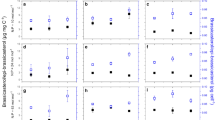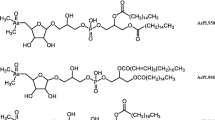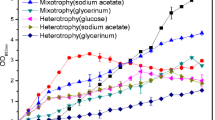Abstract
The hypoxic phenomena of seawater have been found in the Changjiang esturay and its adjacent area for several decades. To study organic matter degradation in seasonal hypoxic seawater, series of stimulated incubation experiments with Skeletonema costatum in seawater under different oxygen saturations were conducted. By tracking variations of lipids originated from the alga, time-dependent concentrations of neutral lipids (hexadecanol, otctadecanol, cholesterol, brassicasterol and phytol) and fatty acids (12:0, 14:0, 16:0, 16:1, 18:0, 18:1(9), 20:5 and 22:6) were obtained during three month of incubation. The results indicate that residence time, oxygen saturation, bacterial community and the structure of lipids were key factors controlling preservation and degradation of lipids in seawater. The degradation rate constants calculated from multi-G model showed that under same oxygen saturation, algal fatty acid degraded faster than neutral lipids, and unsaturated fatty acids degraded faster than saturated fatty acids. Our new discovery showed that degradation rate constant had linear positive correlation with oxygen saturation of seawater, indicating the critical role of oxygen on degradation of algal lipids in hypoxic seawater. The results of this study will be helpful to understand organic carbon cycling in seawater and marine environment more deeply. Future field experiments and investigation should be conducted tracking control factors, especially the role of oxygen saturation on organic matter degradation in natural environment.
Similar content being viewed by others
References
Aller R C. 1984. The importance of relict burrow structures and burrow irrigation in controlling sedimentary solute distributions. Geochimica et Cosmochimica Acta, 48(10): 1 929–1 934.
Azam F, Fenchel T, Field J G, Gray J S, Meyer–Reil L A, Thingstad F. 1983. The ecological role of water column microbes in the sea. Marine Ecology Progress Series, 10(3): 257–263.
Berge J P, Gouygou J P, Dubacq J P, Durand P. 1995. Reassessment of lipid composition of the diatom, Skeletonema costatum. Phytochemistry, 39(5): 1 017–1 021.
Berner R A. 1964. An idealized model of dissolved sulfate distribution in recent sediments. Geochimica et Cosmochimica Acta, 28(9): 1 497–1 503.
Canfield D E. 1994. Factors influencing organic carbon preservation in marine sediments. Chemical Geology, 114(3–4): 315–329.
Caradec S, Grossi V, Gilbert F, Guigue C, Goutx M. 2004. Influence of various redox conditions on the degradation of microalgal triacylglycerols and fatty acids in marine sediments. Organic Geochemistry, 35(3): 277–287.
Cranwell P A, Eglinton G, Robinson N. 1987. Lipids of aquatic organisms as potential contributors to lacustrine sediments—II. Organic Geochemistry, 11(6): 513–527.
Dai J H, Sun M Y. 2007. Organic matter sources and their use by bacteria in the sediments of the Altamaha estuary during high and low discharge periods. Organic Geochemistry, 38(1): 1–15.
Deming J W, Baross J A. 1993. The early diagenesis of organic matter: bacterial activity. In: Engel M H, Macko S A eds. Organic Geochemistry: Principles and Applications. Springer, Boston, MA. p.119–144.
Derieux S, Fillaux J, Saliot A. 1998. Lipid class and fatty acid distributions in particulate and dissolved fractions in the north Adriatic sea. Organic Geochemistry, 29(5–7): 1 609–1 621.
Ding H, Sun M Y. 2005a. Biochemical degradation of algal fatty acids in oxic and anoxic sediment–seawater interface systems: effects of structural association and relative roles of aerobic and anaerobic bacteria. Marine Chemistry, 93(1): 1–19.
Ding H, Sun M Y. 2005b. Effects of intracellular structural associations on degradation of algal chloropigments in natural oxic and anoxic seawaters. Geochimica et Cosmochim i ca Acta, 69(17): 4 237–4 252.
Emerson S, Hedges J I. 1988. Processes controlling the organic carbon content of open ocean sediments. Paleoceanography, 3(5): 621–634.
Fidalgo J P, Cid A, Torres E, Sukenik A, Herrero C. 1998. Effects of nitrogen source and growth phase on proximate biochemical composition, lipid classes and fatty acid profile of the marine microalga Isochrysis galbana. Aquaculture, 166(1–2): 105–116.
Foree E G, McCarty P L. 1970. Anaerobic decomposition of algae. Environmental Science & Technology, 4(10): 842–849.
Fossey J, Lefort D, Sorba J. 1995. Free Radicals in Organic Chemistry. Masson, Paris.
Gagosian R B, Smith S O, Nigrelli G E. 1982. Vertical transport of steroid alcohols and ketones measured in a sediment trap experiment in the equatorial Atlantic Ocean. Geochim i ca et Cosmochim i ca Acta, 46(7): 1 163–1 172.
Gagosian R B, Volkman J K, Nigrelli G E. 1983. The use of sediment traps to determine sterol sources in coastal sediments offPeru. In: Advances in Organic Geochemistry, 1981. Wiley, Chichester. p.369–379.
Galea A M, Brown A J. 2009. Special relationship between sterols and oxygen: were sterols an adaptation to aerobic life? Free R radical Biology and M edicine, 47(6): 880–889.
HallegraeffG M, Nichols P D, Volkman J K, Blackburn S I, Everitt D A. 1991. Pigments, fatty acids, and sterols of the toxic dinoflagellate Gymnodinium catenatum. Journal of Phycology, 27(5): 591–599.
Hartnett H E, Keil R G, Hedges J I, Devol A H. 1998. Influence of oxygen exposure time on organic carbon preservation in continental margin sediments. Nature, 391(6667): 572–575.
Harvey H R, Macko S A. 1997. Kinetics of phytoplankton decay during simulated sedimentation: changes in lipids under oxic and anoxic conditions. Organic Geochemistry, 27(3–4): 129–140.
Harvey H R, Tuttle J H, Bell J T. 1995. Kinetics of phytoplankton decay during simulated sedimentation: changes in biochemical composition and microbial activity under oxic and anoxic conditions. Geochimica et Cosmochimica Acta, 59(16): 3 367–3 377.
Hedges J I, Keil R G. 1999. Organic geochemical perspectives on estuarine processes: sorption reactions and consequences. Marine Chemistry, 65(1–2): 55–65.
Jewell W J, McCarty P L. 1971. Aerobic decomposition of algae. Environmental Science and Technology, 5(10): 1 023–1 031.
Jiao N Z, Herndl G J, Hansell D A, Benner R, Kattner G, Wilhelm S W, Kirchman D L, Weinbauer M G, Luo T W, Chen F, Azam F. 2010. Microbial production of recalcitrant dissolved organic matter: long–term carbon storage in the global ocean. Nature Reviews Microbiology, 8: 593–599.
Lee C. 1992. Controls on organic carbon preservation: the use of stratified water bodies to compare intrinsic rates of decomposition in oxic and anoxic systems. Geochimica et Cosmochimica Acta, 56(8): 3 323–3 335.
Li W, Ding H, Yang G P, Sui W, Sun L. 2014. Simulated study of lipid degradation in hypoxia sea water. Periodical of Ocean University of China, 44(sup.): 112–129.(in Chinese)
Lin J. 2007. Distribution of dissolved organic carbon and particulate organic carbon in the Changjiang estuary and its adjacent area. Master thesis, East China Normal University.(in Chinese)
Liu Z G, Xu R, Liu C C, Qin Y T, Cai P. 2012. Characters of hypoxia area offthe Yangtze River estuary and its influence. Marine Science Bulletin, 31(5): 588–593.(in Chinese with English abstract)
Louda J W, Jie L, Lei L, Winfree M N, Baker E W. 1998. Chlorophyll–a degradation during cellular senescence and death. Organic Geochemistry, 29(5–7): 1 233–1 251.
Lü D W, Song Q, Wang X C. 2010a. Decomposition of algal lipids in clay–enriched marine sediment under oxic and anoxic conditions. Chinese Journal of Oceanology and Limnology, 28(1): 131–143.
Lv X X, Zou L, Sun B W, Wang J T, Sun M Y. 2010b. Variations in lipid yields and compositions of marine microalgae during cell growth and respiration, and within intracellular structures. Journal of Experimental Marine Biology and Ecology, 391(1–2): 73–83.
Mohammady N G. 2004. Total, free and conjugated sterolic forms in three microalgae used in mariculture. Zeitschrift f ü r Naturforschung C, 59(9–10): 619–624.
Nealson D L, Cox M M. 2012. Lehninger Principles of Biochemistry. 6 th edn. W. H. Freeman, New York.
Otsuki A, Hanya T. 1972a. Production of dissolved organic matter from dead green algal cells. I. Aerobic microbial decomposition. Limnology and Oceanography, 17(2): 248–257.
Otsuki A, Hanya T. 1972b. Production of dissolved organic matter from dead green algal cells. II. Anaerobic microbial decomposition. Limnology and Oceanography, 17(2): 258–264.
Pan H, Culp R A, Sun M Y. 2017. Influence of physiological states of Emiliania huxleyi cells on their lipids and associated molecular isotopic compositions during microbial degradation. Journal of Experimental Marine Biology and Ecology, 488: 1–9.
Parkes R J, Taylor J. 1983. The relationship between fatty acid distribution and bacterial respiratory types in contemporary marine sediments. Estuarine, Coastal and Shelf Science, 16(2): 173–174. IN5, 175–189.
Popovich C A, Damiani C, Constenla D, Leonardi P I. 2012. Lipid quality of the diatoms Skeletonema costatum and Navicula gregaria from the South Atlantic Coast (Argentina): evaluation of its suitability as biodiesel feedstock. Journal of Applied Phycology, 24(1): 1–10.
Pruski A M, Buscail R, Bourgeois S, Vétion G, Coston–Guarini J G, Rabouille C. 2015. Biogeochemistry of fatty acids in a river–dominated Mediterranean ecosystem(Rhône River prodelta, Gulf of Lions, France): origins and diagenesis. Organic Geochemistry, 83–84: 227–240.
Rontani J F, Marchand D. 2000. Photoproducts of phytoplanktonic sterols: a potential source of hydroperoxides in marine sediments? Organic Geochemistry, 31(2–3): 169–180.
Rontani J F, Vaultier F, Bonin P. 2014. Biotic and abiotic degradation of marine and terrestrial higher plant material in intertidal surface sediments from Arcachon Bay (France): a lipid approach. Marine Chemistry, 158: 69–79.
Rontani J F, Volkman J K, Prahl F G, Wakeham S G. 2013. Biotic and abiotic degradation of alkenones and implications for U 37 K’ paleoproxy applications: a review. Organic Geochemistry, 59: 95–113.
Sánchez S, Martínez M A E, Molina E, de la Casa J A, García F. 1993. The influence of culture media and aeration rate on the growth and fatty–acid content Skeletonema costatum. Process Biochemistry, 28(5): 289–296.
Schoch S, Brown J. 1987. The action of chlorophyllase on chlorophyll–protein complexes. Journal of Plant Physiology, 126(4–5): 483–494.
Servel M O, Claire C, Derrien A, Coiffard L, de Roeck–Holtzhauer Y. 1994. Fatty acid composition of some marine microalgae. Phytochemistry, 36(3): 691–693.
Sun B Y, Liang S K, Wang C Y, Wang X B, Wang X L, Li Y B. 2008. Role of irradiance on the seasonality of Skeletonema costatum cleve blooms in the coastal area in East China Sea. Environmental Science, 29(7): 1 849–1 854.(in Chinese with English abstract)
Sun J, Song S Q. 2009. Phytoplankton growth and microzooplankton herbivory during the spring phytoplankton bloom period in the East China Sea. Acta Ecologica Sinica, 29(12): 6 429–6 438.(in Chinese with English abstract)
Sun M Y, Aller R C, Lee C, Wakeham S G. 2002. Effects of oxygen and redox oscillation on degradation of cellassociated lipids in surficial marine sediments. Geochimica et Cosmochimica Acta, 66(11): 2 003–2 012.
Sun M Y, Dai J H. 2005. Relative influences of bioturbation and physical mixing on degradation of bloom–derived particulate organic matter: clue from microcosm experiments. Marine Chemistry, 96(3–4): 201–218.
Sun M Y, Shi W, Lee R F. 2000. Lipid–degrading enzyme activities associated with distribution and degradation of fatty acids in the mixing zone of Altamaha estuarine sediments. Organic Geochemistry, 31(9): 889–902.
Sun M Y, Wakeham S G, Lee C. 1997. Rates and mechanisms of fatty acid degradation in oxic and anoxic coastal marine sediments of Long Island Sound, New York, USA. Geochimica et Cosmochimica Acta, 61(2): 341–355.
Sun M Y, Wakeham S G. 1998. A study of oxic/anoxic effects on degradation of sterols at the simulated sediment–water interface of coastal sediments. Organic Geochemistry, 28(12): 773–784.
Sun M Y, Zou L, Dai J H, Ding H, Culp R A, Scranton M I. 2004. Molecular carbon isotopic fractionation of algal lipids during decomposition in natural oxic and anoxic seawaters. Organic Geochemistry, 35(8): 895–908.
Suzuki T, Matsuyama Y. 1995. Determination of free fatty acids in marine phytoplankton causing red tides by fluorometric high–performance liquid chromatography. Journal of the American Oil Chemists’ Society, 72(10): 1 211–1 214.
Teece M A, Getliff J M, Leftley J W, Parkes R J, Maxwell J R. 1998. Microbial degradation of the marine prymnesiophyte Emiliania huxleyi under oxic and anoxic conditions as a model for early diagenesis: long chain alkadienes, alkenones and alkyl alkenoates. Organic Geochemistry, 29(4): 863–880.
Urbani R, Magaletti E, Sist P, Cicero A M. 2005. Extracellular carbohydrates released by the marine diatoms Cylindrotheca closterium, Thalassiosira pseudonana and Skeletonema costatum: effect of P–depletion and growth status. Science of the Total Environment, 353(1–3): 300–306.
Vieler A, Wilhelm C, Goss R, Süß R, Schiller J. 2007. The lipid composition of the unicellular green alga Chlamydomonas reinhardtii and the diatom Cyclotella meneghiniana investigated by MALDI–TOF MS and TLC. Chemistry and Physics of Lipids, 150(2): 143–155.
Voet D, Voet J G. 2011. Biochemistry. 4 th edn. John Wiley and Sons, Inc., Hoboken, NJ.
Volkman J K, Farrington J W, Gagosian R B. 1987. Marine and terrigenous lipids in coastal sediments from the Peru upwelling region at 15°S: sterols and triterpene alcohols. Organic Geochemistry, 11(6): 463–477.
Wakeham S G, Beier J A. 1991. Fatty acid and sterol biomarkers as indicators of particulate matter source and alteration processes in the Black Sea. Deep Sea Research Part A. Oceanographic Research Papers, 38(S2): S943–S968.
Wakeham S G, Lee C. 1993. Production, transport, and alteration of particulate organic matter in the marine water column. In: Engel M H, Macko S A eds. Organic Geochemistry: Principles and Applications. Springer, Boston, MA. p.145–169.
Wang B D, Wei Q S, Chen J F, Xie L P. 2012. Annual cycle of hypoxia offthe Changjiang(Yangtze River) estuary. Marine Environmental Research, 77: 1–5.
Westrich J T, Berner R A. 1984. The role of sedimentary organic matter in bacterial sulfate reduction: the G model tested. Limnology and Oceanography, 29(2): 236–249.
Yang S, Wu R S S, Kong R Y C. 2002. Biodegradation and enzymatic responses in the marine diatom Skeletonema costatum upon exposure to 2, 4–dichlorphenol. Aquatic Toxicology, 59(3–4): 191–200.
Acknowledgement
The authors are grateful to all of members help in the Marine Interface Chemistry Lab in the Ocean University of China. The authors also appreciate Ms. Rose Jaffe and Mr. Dani Cox from the University of California at Santa Barbara to help us polish this paper.
Author information
Authors and Affiliations
Corresponding author
Additional information
Supported by the National Natural Science Foundation of China for Creative Groups (No. 41521064), the National Natural Science Foundation of China (No. 41676067), the Fundamental Funds for Central Universities (No. 201762030), the National Key Research and Development Program of China (No. 2016YFA0601302), and the Natural Science Foundation of Shandong Province (No. ZR2010DM001)
Rights and permissions
About this article
Cite this article
He, Y., Sun, C., Li, W. et al. Degradation of lipids in seasonal hypoxic seawater under different oxygen saturation. J. Ocean. Limnol. 36, 1570–1585 (2018). https://doi.org/10.1007/s00343-018-7110-0
Received:
Accepted:
Published:
Issue Date:
DOI: https://doi.org/10.1007/s00343-018-7110-0




